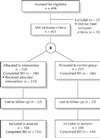Interventions led by nurse continence advisers in the management of urinary incontinence: a randomized controlled trial
- PMID: 12041843
- PMCID: PMC111077
Interventions led by nurse continence advisers in the management of urinary incontinence: a randomized controlled trial
Abstract
Background: The short-term efficacy of combined lifestyle and behavioural interventions led by nurses in the management of urinary incontinence has not been rigorously evaluated by randomized controlled trial. We conducted a 6-month randomized controlled trial to determine whether a model of service delivery that included lifestyle and behavioural interventions led by "nurse continence advisers" in collaboration with a physician with expertise in continence management could reduce urinary incontinence and pad use in an outpatient population. We also aimed to evaluate the impact of this approach on subjects' knowledge about incontinence and their quality of life.
Methods: We used advertising in the mainstream media, newsletters to family physicians and community information sessions in 1991 to invite volunteers who were 26 years of age or older and suffered from incontinence to participate in a randomized controlled trial. Men and women who met the eligibility criteria were randomly allocated to receive either counselling from specialized nurses to manage incontinence using behavioural and lifestyle modification sessions every 4 weeks for 25 weeks or usual care. Symptoms of incontinence and the use of incontinence pads were the primary outcome measures.
Results: Using sealed envelopes, 421 patients were randomly allocated to the treatment or control groups. On average, patients in the treatment group experienced 2.1 "incontinent events" per 24 hours before treatment and 1.0 incontinent event per 24 hours at the end of the study. Control patients had an average of 2.4 incontinent events per 24 hours before the study and 2.2 incontinent events per 24 hours at the end of the study. The mean decrease in events in the treatment group was 1.2 and in the control group 0.2 (p = 0.001). Pad use declined from a mean of 2.2 per 24 hours before randomization in the treatment group to 1.2 per 24 hours at the end of the study, compared with 2.6 pads per 24 hours in the control group at the start of the study and 2.4 per 24 hours at the end. Pad use per 24 hours decreased on average by 0.9 pads in the treatment group and 0.1 in the control group (p = 0.021).
Interpretation: Behavioural and lifestyle counselling provided by specialized nurses with training in managing incontinence reduces incontinent events and incontinence pad use.
Figures
References
-
- National Institutes of Health. Urinary incontinence in adults: consensus conference. JAMA 1989;261:2685-90. - PubMed
-
- The Canadian Continence Foundation. Promoting a collaborative consumer-focused approach to continence care in Canada. Westmount (QC): The Foundation; 2001. Available: www.continence-fdn.ca (accessed 2002 Feb 15).
-
- Fantl JA, Newman DK, Colling J, DeLancey JOL, Keeys C, Loughery R, et al. Urinary incontinence in adults: acute and chronic management. Clinical Practice Guideline No. 2, 1996 Update. Rockville (MD): US Department of Health and Human Services, Agency for Health Care Policy and Research; 1996. AHCPR publication no. 96-0682.
-
- Mohide EA. The prevalence and scope of urinary incontinence. Clin Geriatr Med 1986;2:639-55. - PubMed
-
- Burgio KL, Matthews KA, Engel BT. Prevalence, incidence and correlates of urinary incontinence in healthy, middle-aged women. J Urol 1991;146:1255-9. - PubMed
Publication types
MeSH terms
LinkOut - more resources
Full Text Sources
Medical
Miscellaneous


